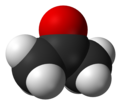Acetone
Acetone, or propanone, is an organic compound with the chemical formula (CH
3)
2CO. This clear, mobile, easy-to-burn liquid is the simplest example of the ketones. Acetone can be mixed with water. It is an important solvent, often to clean things in the laboratory. Common uses of acetone in the home are as the active ingredient in nail polish remover and as paint thinner. It is a common building block in organic chemistry.
| Acetone[1] | |
|---|---|

| |
Propan-2-one[2] | |
| Other names | |
| Identifiers | |
| CAS number | |
| PubChem | |
| EC number | 200-662-2 |
| KEGG | D02311 |
| MeSH | |
| ChEBI | CHEBI:15347 |
| RTECS number | AL3150000 |
| SMILES | CC(=O)C |
| Beilstein Reference | 635680 |
| Gmelin Reference | 1466 |
| 3DMet | B00058 |
| Properties | |
| Molecular formula | C3H6O |
| Molar mass | 58.07 g mol-1 |
| Appearance | Colorless liquid |
| Odor | Pungent, irritating, floral, cucumber like |
| Density | 0.7845 g/cm3 (25 °C) |
| Melting point |
−94.7 °C, 178 K, -138 °F |
| Boiling point | |
| Solubility in water | Miscible |
| Solubility | Miscible in benzene, diethyl ether, methanol, chloroform, ethanol[8] |
| log P | -0.16[9] |
| Vapor pressure |
|
| Acidity (pKa) | |
| −33.78·10−6 cm3/mol | |
| Refractive index (nD) | 1.3588 (VD = 54.46) |
| Viscosity | 0.295 mPa·s (25 °C)[8] |
| Structure | |
| Coordination geometry |
Trigonal planar at C2 |
| Molecular shape | Dihedral at C2 |
| Dipole moment | 2.91 D |
| Thermochemistry | |
| Std enthalpy of formation ΔfH |
(−250.03) – (−248.77) kJ/mol |
| Std enthalpy of combustion ΔcH |
−1.772 MJ/mol |
| Standard molar entropy S |
200.4 J/(mol·K) |
| Specific heat capacity, C | 125.45 J/(mol·K) |
| Hazards | |
| NFPA 704 |
|
| Explosive limits | 2.6–12.8%[12] |
| U.S. Permissible exposure limit (PEL) |
1000 ppm (2400 mg/m3)[7] |
| Except where noted otherwise, data are given for materials in their standard state (at 25 °C, 100 kPa) | |
Acetone Media
Sources
- ↑ The Merck Index, 15th Ed. (2013), p. 13, Acetone Monograph 65, O'Neil: The Royal Society of Chemistry.(subscription needed)
- ↑ Nomenclature of Organic Chemistry : IUPAC Recommendations and Preferred Names 2013 (Blue Book). Cambridge: The Royal Society of Chemistry. 2014. p. 723. doi:10.1039/9781849733069-FP001. ISBN 978-0-85404-182-4.
- ↑ 3.0 3.1 3.2 3.3 Acetone in Linstrom, Peter J.; Mallard, William G. (eds.); NIST Chemistry WebBook, NIST Standard Reference Database Number 69, National Institute of Standards and Technology, Gaithersburg (MD), http://webbook.nist.gov (retrieved 2014-05-11)
- ↑ Klamt, Andreas (2005). COSMO-RS: From Quantum Chemistry to Fluid Phase Thermodynamics and Drug Design. Elsevier. pp. 92–94. ISBN 978-0-444-51994-8.
- ↑ Ash, Michael; Ash, Irene (2004). Handbook of preservatives. Synapse Information Resources, Inc. p. 369. ISBN 1-890595-66-7.
- ↑ Myers, Richard L. (2007). The 100 Most Important Chemical Compounds: A Reference Guide. Greenwood. pp. 4–6. ISBN 978-0-313-08057-9.
- ↑ 7.0 7.1 NIOSH Pocket Guide to Chemical Hazards. "#0260". National Institute for Occupational Safety and Health (NIOSH).
- ↑ 8.0 8.1 Properties of substance: acetone. chemister.ru.
- ↑ "acetone". ChemSrc. Retrieved 2018-04-13.
- ↑ Chiang, Yvonne; Kresge, A. Jerry; Tang, Yui S.; Wirz, Jakob (1984). "The pKa and keto-enol equilibrium constant of acetone in aqueous solution". Journal of the American Chemical Society. 106 (2): 460–462. doi:10.1021/ja00314a055.
- ↑ Bordwell, Frederick G. (1988). "Equilibrium acidities in dimethyl sulfoxide solution". Accounts of Chemical Research. 21 (12): 456–463. doi:10.1021/ar00156a004. S2CID 26624076.
- ↑ "Working with modern hydrocarbon and oxygenated solvents: a guide to flammability". American Chemistry Council Solvents Industry Group. January 2008. p. 7. Archived from the original on 2009-06-01.





